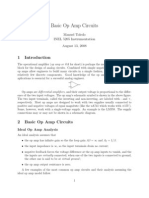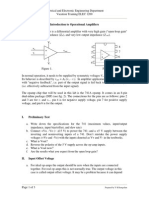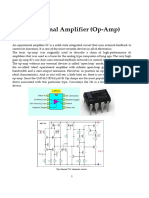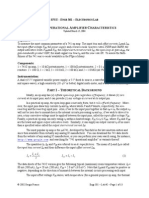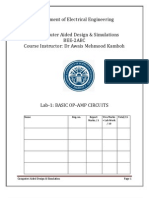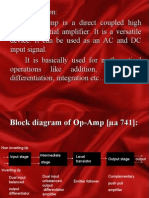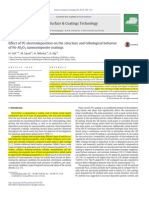Effects of Operational Amplifier (Op-Amp) Non-Idealities.: R V I R R V V
Effects of Operational Amplifier (Op-Amp) Non-Idealities.: R V I R R V V
Uploaded by
Mohammad Nasfikur Rahman KhanCopyright:
Available Formats
Effects of Operational Amplifier (Op-Amp) Non-Idealities.: R V I R R V V
Effects of Operational Amplifier (Op-Amp) Non-Idealities.: R V I R R V V
Uploaded by
Mohammad Nasfikur Rahman KhanOriginal Title
Copyright
Available Formats
Share this document
Did you find this document useful?
Is this content inappropriate?
Copyright:
Available Formats
Effects of Operational Amplifier (Op-Amp) Non-Idealities.: R V I R R V V
Effects of Operational Amplifier (Op-Amp) Non-Idealities.: R V I R R V V
Uploaded by
Mohammad Nasfikur Rahman KhanCopyright:
Available Formats
op-ampnonidealVosIBIos.
doc Page 1 28/11/2011
Effects of operational amplifier (op-amp) non-idealities.
Consider each effect in turn creating output error voltages AV
o
due to each non-ideality in
turn, with the op-amp otherwise considered ideal.
Imagine other voltage inputs (for non-inverting v
+
or inverting v
) short circuited (s/c) to
0V, then find total output effects by superposition.
Note that the dc power supply rails, V
s
are not shown in the following diagrams.
1. Offset voltage, V
os
= v
v
+
V
os
may be positive (+ve) or negative (ve).
(a) Non-inverting amplifier: input signal, v
in
heading towards non-inverting (+) input
v
_
+
v
in
=0V
v
o
=AV
o
due to V
os
R
1
0V
15kO
R
f
60kO
V
os
I
v
+
non-inverting amplifier circuit diagram
1
os
R
V
I = , and the same current also flows through R
f
,
so the voltage drop across R
f
is IR
f
=
f
1
os
R
R
V
This gives an error output voltage, AV
o
= V
os
+ IR
f
= V
os
+
f
1
os
R
R
V
=
os
1
f
V
R
R
1
|
|
.
|
\
|
+
For this circuit the offset error voltage, V
os
is multiplied by the same numerical voltage gain
as for normal v
in
input signals, ideal non-inverting gain, A
v
=
1
f
R
R
1 +
normal output, v
o
= A
v
v
in
op-ampnonidealVosIBIos.doc Page 2 28/11/2011
(b) Inverting amplifier: input signal or level, v
in
heading towards inverting () input
60kO R
f
15kO R
in
_
+
v
in
0V v
o
0V
V
os
I
I
inverting amplifier circuit diagram
As for the previous circuit,
in
os
R
V
I = , and the same current also flows through R
f
,
so again the voltage drop across R
f
is IR
f
=
f
in
os
R
R
V
This gives an error output voltage, AV
o
= V
os
+ IR
f
= V
os
+
f
in
os
R
R
V
=
os
in
f
V
R
R
1
|
|
.
|
\
|
+
Thus both inverting and non-inverting have error due to V
os
, AV
o
=
os
f
V
R
R
1 |
.
|
\
|
+
with appropriate R.
However, for this inverting circuit the gain for V
os
is not the same as the gain for normal
input v
in
signals.
Normal inverting numerical voltage gain, A
v
=
in
f
in
o
R
R
v
v
= assuming ideal op-amps
Signal output, v
o
= A
v
v
in
op-ampnonidealVosIBIos.doc Page 3 28/11/2011
2. Bias current effects
Data sheets give average bias currents, I
B+
and I
B
, (or i
+
and i
), flowing into (or out of)
the non-inverting (+) and inverting () inputs as I
BIAS
=
2
I I
B B +
+
.
The input offset current error source is I
os
= I
B+
I
B
= i
+
i
Ideal op-amp operation brings v
+
to the same voltage as v
.
v
+
= i
+
R
B
v
= i
+
R
B
giving I =
1
B
1
R
R i
R
v
+
= , I
F
= I i
=
1
B
R
R i
+
i
AV
o
= v
+
+ I
F
R
F
= i
+
R
B
+
F
1
B
R i
R
R i
|
|
.
|
\
|
+
=
( )
F
1
F 1 B
R i
R
R R R i
+
Then make R
B
=
( )
F 1
F 1
R R
R R
+
, which is the parallel combination of R
1
and R
F
,
giving error AV
o
= ( )
F OS F F F
R I R . i i R i R i = =
+ +
This allows the remaining error due to I
os
to be nulled or trimmed out by similar methods
as used for V
os
A similar analysis for the non-inverting amplifier shows that the inclusion of R
B
as below
can help reduce bias current errors for this circuit too. (parallel combination shorthand R
1
,, R
F
)
error AV
o
due to bias
currents
+
R
B
R
F
i
+
v
i
R
1
0V
v
+
V
1
=0V
error AV
o
due to bias
currents
+
R
1
R
F
i
+
v
i
R
B
I
0V
v
+
V
1
=0V
I
F
inverting amplifier
op-ampnonidealVosIBIos.doc Page 4 28/11/2011
3. Estimate effects due to errors, specified limits & practical component tolerances.
Check which are dominant - which do need dealing with - for good performance over the
required dynamic ranges.
Make good use of manufacturer's datasheets and application hints.
(a) Check the likely effects of the resistor tolerances, of resistor pairs not being perfectly
matched and of op-amp non-idealities. Estimate potential variations from ideal theory due
to realistic component tolerances. Resistor values may be 5%, capacitor values may be
20%, for instance. Variations due to tolerances and due to time or temperature drifts may
be reduced by using expensive precision components, if required by the application.
(b) Before practically testing an amplifier circuit, try nulling the op-amp's offset to minimise
V
os
and I
os
errors (with the 15V supply rails connected), eg for the A741by connecting
the v
+
and v
inputs to 0V and adjusting v
o
to 0V using a variable resistor between pins 1
and 5 with its wiper connected to 15V, or by using the summing input. Alternatively, an
op-amp with a better specification (spec) may be needed.
(c) Add appropriate resistances (R
B
) to minimise I
BIAS
effects.
(d) To predict the frequency response of a linear op-amp circuit from dc upwards:
The frequency, f
H
, where the output voltage has reduced from its steady mid-band/low f
value by
2
1
, corresponds to the 3dB half-power point.
Operational amplifiers without external components limiting their low frequency gain
normally provide no lower frequency limit, they will amplify down to dc, so f
L
= 0 Hertz,
and bandwidth (BW) = f
H
f
L
= f
H
For regions where the numerical gain multiplied by the bandwidth (BW) is constant
(gain.BW product = constant = unity gain BW), the bandwidth can be estimated by using
the unity gain BW from the op-amp specifications (eg the manufacturer's datasheet).
The BW at some other gain is ideally a scaled version of this, found by dividing by the new
non-inverting numerical gain, so new f
H
= new BW =
gain new
product BW . gain
(e) To practically estimate slew rate = maximum rate of change of v
o
, try square wave
inputs with increasing frequency to a unity gain buffer amp, measure max
t
V
o
A
A
in V/s.
For sinusoidal input & output signals and an output amplitude V
p
, (where V
p
= A
v
input
amplitude): slew rate = s V/ in 10 V f 2
dt
dv
6
p max
max
o
t =
When V
p
is at its maximum, then f
max
is the full power bandwidth.
(f) Check limits (clipping distortion) due to dc power supply rail voltages, V
s
.
You might also like
- Lab Report of DynamicsDocument15 pagesLab Report of DynamicsUmer Abbas100% (4)
- Crane Lift PlanDocument4 pagesCrane Lift Planabdalla el-saadaney100% (1)
- AMA Marketing Communications PlaybookDocument29 pagesAMA Marketing Communications PlaybookMai Linh BùiNo ratings yet
- 2013 Input Output Impedance 9Document20 pages2013 Input Output Impedance 9Vinit PatelNo ratings yet
- Final Op Amp Lab ReportDocument7 pagesFinal Op Amp Lab Reportmehrin12367% (3)
- Devices Experiment 1 - Inverting and Non-InvertingDocument16 pagesDevices Experiment 1 - Inverting and Non-InvertingYanique Gibbs100% (1)
- Advanced GRE Math QuestionsDocument22 pagesAdvanced GRE Math Questionsmulasravanialekhya84% (19)
- City Facilities Management - ASDA Cleaning - Application FormDocument4 pagesCity Facilities Management - ASDA Cleaning - Application FormMohammad Nasfikur Rahman Khan40% (5)
- Messer X Axis Motor 4292.1347Document2 pagesMesser X Axis Motor 4292.1347David CraigNo ratings yet
- Case Analysis Worksheet: Define The ProblemDocument1 pageCase Analysis Worksheet: Define The ProblemShehab OsmanNo ratings yet
- China Aluminum International Engineering Corporation Limited (CHALIECO)Document19 pagesChina Aluminum International Engineering Corporation Limited (CHALIECO)Weiji WangNo ratings yet
- Lectures 16 To 18 - Op-AmpDocument19 pagesLectures 16 To 18 - Op-AmpAniketsingh MundlothNo ratings yet
- Op Amp NotesDocument34 pagesOp Amp NotesUma ShankarNo ratings yet
- Aic Unit 3Document96 pagesAic Unit 3SYETC156HARSHAL RAHENWALNo ratings yet
- Basic AppsDocument10 pagesBasic AppsajayganeshNo ratings yet
- Linear Amplifiers and Opamps: I + Av - + V I Z V Z R RDocument19 pagesLinear Amplifiers and Opamps: I + Av - + V I Z V Z R RAnimesh GhoshNo ratings yet
- Operational Amplifiers: Kristin Ackerson, Virginia Tech Ee Spring 2002 - Vtech - Calvin Project For Prof. RibeiroDocument29 pagesOperational Amplifiers: Kristin Ackerson, Virginia Tech Ee Spring 2002 - Vtech - Calvin Project For Prof. Ribeirodheep_infotel3985100% (2)
- Linear Applications of Op-AmpsDocument94 pagesLinear Applications of Op-AmpsManar HosnyNo ratings yet
- Operational Amplifier CharacterizationDocument24 pagesOperational Amplifier CharacterizationMohammad IbrahimNo ratings yet
- Expt 4Document14 pagesExpt 4Krunal PatelNo ratings yet
- G6 PDFDocument9 pagesG6 PDFJagadish KgNo ratings yet
- Experiment 2 - 2021AAPS3021HDocument9 pagesExperiment 2 - 2021AAPS3021Hasheshverma2003No ratings yet
- Purpose: Lab 5 Operational Amplifier Applications IDocument6 pagesPurpose: Lab 5 Operational Amplifier Applications IRuma KhanomNo ratings yet
- AEC 4Document30 pagesAEC 4SAROJ KUMARNo ratings yet
- Lic Lab ManualDocument89 pagesLic Lab ManualKALAIMATHI100% (1)
- Op-Amps: I. Practical Op-AmpDocument7 pagesOp-Amps: I. Practical Op-AmpSteven Nelson100% (1)
- 21 - ElectronicsDocument38 pages21 - ElectronicsKamran Khursheed100% (1)
- Opamp DesignDocument27 pagesOpamp DesignAbhishek DwivediNo ratings yet
- AnalogDocument33 pagesAnalogAmit UpadhyayNo ratings yet
- Acd Lab ManualDocument34 pagesAcd Lab ManualAbhishek PatelNo ratings yet
- Introduction To Operational Amplifiers: 0 in OutDocument3 pagesIntroduction To Operational Amplifiers: 0 in Outjaya1816No ratings yet
- Lecture 8Document8 pagesLecture 8Mister TomNo ratings yet
- EXP10Document7 pagesEXP10Abhigyan SinghNo ratings yet
- Basic AppsDocument10 pagesBasic AppsHendra LeosuNo ratings yet
- Exp 02 CSE251 Fall 2024Document8 pagesExp 02 CSE251 Fall 2024sujailyunus84No ratings yet
- Chap4a OpAmpDocument37 pagesChap4a OpAmpAl AidenNo ratings yet
- UNIT 3-Cluster - 4Document67 pagesUNIT 3-Cluster - 4Anvesh MagantiNo ratings yet
- L #2: O A C: Sfsu - E 301 - E L AB Perational Mplifier HaracteristicsDocument13 pagesL #2: O A C: Sfsu - E 301 - E L AB Perational Mplifier HaracteristicsRudra MishraNo ratings yet
- Operational Amplifiers (Op Amps) : Voltages. Symbol For An Op-AmpDocument8 pagesOperational Amplifiers (Op Amps) : Voltages. Symbol For An Op-AmpRaymond ScottNo ratings yet
- FEEE Module 4Document28 pagesFEEE Module 4jthangelNo ratings yet
- Lab - 01 (BME-202)Document9 pagesLab - 01 (BME-202)Darakhshan MujtabaNo ratings yet
- OpAmp Q PDFDocument31 pagesOpAmp Q PDFShahbaz AhmedNo ratings yet
- Exp 7Document3 pagesExp 7MohammedZahidNo ratings yet
- Op AmpDocument74 pagesOp AmpACSVNo ratings yet
- Lab 1 Operational AmplifiersDocument12 pagesLab 1 Operational AmplifiersChris BrownNo ratings yet
- Notes and Questions On-Op AmpDocument11 pagesNotes and Questions On-Op AmpjitenNo ratings yet
- DC CharteristDocument7 pagesDC CharteristDr.S.Jaganathan HoD EEENo ratings yet
- Op AmpsDocument47 pagesOp Ampssuresh_karthik_9No ratings yet
- Sistec: Sagar Group of InstitutionsDocument28 pagesSistec: Sagar Group of InstitutionsdeeptimalviyaNo ratings yet
- Lab 1 PSpice Op - Amp - BasicsDocument13 pagesLab 1 PSpice Op - Amp - BasicsTooba ArshadNo ratings yet
- Notes OpAmp F05 PDFDocument8 pagesNotes OpAmp F05 PDFmouneshskNo ratings yet
- Unit 1 Characteristics of Opamp & Its FundamentalsDocument34 pagesUnit 1 Characteristics of Opamp & Its FundamentalsKamalNo ratings yet
- Op Amps Working PDFDocument9 pagesOp Amps Working PDFDeepuVasantNo ratings yet
- Djukarna Stkip Surya Serpong, BantenDocument34 pagesDjukarna Stkip Surya Serpong, BantenjainamshahNo ratings yet
- Opaamp NewwwDocument20 pagesOpaamp NewwwArpita SharmaNo ratings yet
- OP AmP Aplications ConvertedDocument70 pagesOP AmP Aplications Convertedshehansanjeewa822No ratings yet
- Unit-03 OpamDocument12 pagesUnit-03 Opamsy2526462No ratings yet
- Chapter 4 Op-AmpDocument25 pagesChapter 4 Op-Ampfirst lastNo ratings yet
- Inverting Operational Amplifier Configuration: X + RinDocument10 pagesInverting Operational Amplifier Configuration: X + RinYousif AlaaNo ratings yet
- Inverting AmplifierDocument9 pagesInverting AmplifierKenzie WalipiNo ratings yet
- Epc M3Document13 pagesEpc M3karanphutane2254No ratings yet
- Opamp PesentationDocument34 pagesOpamp Pesentation2shreedNo ratings yet
- Unit - 6 Operational Amplifier: Fig.6.1 Symbol of Op-AmpDocument12 pagesUnit - 6 Operational Amplifier: Fig.6.1 Symbol of Op-AmpJovita LasradoNo ratings yet
- Easy(er) Electrical Principles for General Class Ham License (2015-2019)From EverandEasy(er) Electrical Principles for General Class Ham License (2015-2019)Rating: 5 out of 5 stars5/5 (1)
- Reference Guide To Useful Electronic Circuits And Circuit Design Techniques - Part 1From EverandReference Guide To Useful Electronic Circuits And Circuit Design Techniques - Part 1Rating: 2.5 out of 5 stars2.5/5 (3)
- Bolte Chai: An Augmentative and Alternative Communication Device For Enhancing Communication For Nonverbal ChildrenDocument7 pagesBolte Chai: An Augmentative and Alternative Communication Device For Enhancing Communication For Nonverbal ChildrenMohammad Nasfikur Rahman KhanNo ratings yet
- Improving The Design and Operation of A Finger SimulatorDocument12 pagesImproving The Design and Operation of A Finger SimulatorMohammad Nasfikur Rahman KhanNo ratings yet
- Ni-Based Electrodeposited Composite Coating Exhibiting Improved Microhardness, Corrosion and Wear Resistance PropertiesDocument7 pagesNi-Based Electrodeposited Composite Coating Exhibiting Improved Microhardness, Corrosion and Wear Resistance PropertiesMohammad Nasfikur Rahman KhanNo ratings yet
- Week 4: Casting Is A ProcessDocument2 pagesWeek 4: Casting Is A ProcessMohammad Nasfikur Rahman KhanNo ratings yet
- Effect of PC Electrodeposition On The Structure and Tribological BehaviorDocument10 pagesEffect of PC Electrodeposition On The Structure and Tribological BehaviorMohammad Nasfikur Rahman KhanNo ratings yet
- Report of Self-Lubricating Al2O3-based NanocompositesDocument8 pagesReport of Self-Lubricating Al2O3-based NanocompositesMohammad Nasfikur Rahman KhanNo ratings yet
- Shoulder Arthroscopy Presentation v0.4Document20 pagesShoulder Arthroscopy Presentation v0.4Mohammad Nasfikur Rahman KhanNo ratings yet
- % Rectangular Single PulseDocument5 pages% Rectangular Single PulseMohammad Nasfikur Rahman KhanNo ratings yet
- Journey Information: Getting Your Tickets: Self-Service Ticket Machine Collection Reference: HC393699Document2 pagesJourney Information: Getting Your Tickets: Self-Service Ticket Machine Collection Reference: HC393699Mohammad Nasfikur Rahman KhanNo ratings yet
- Drawing FacesDocument17 pagesDrawing FacesMickShazan90% (20)
- Student and Learning Services Student Researcher (Up To 10 Posts Available) 8.00 Per Hour Part Time (Average 7.5 Hours Per Week) Closing DateDocument4 pagesStudent and Learning Services Student Researcher (Up To 10 Posts Available) 8.00 Per Hour Part Time (Average 7.5 Hours Per Week) Closing DateMohammad Nasfikur Rahman KhanNo ratings yet
- VHDL Examples: CombinationalDocument4 pagesVHDL Examples: CombinationalMohammad Nasfikur Rahman KhanNo ratings yet
- Guidelines For Lab ReportDocument4 pagesGuidelines For Lab ReportMuhammad KhairaniNo ratings yet
- GX Developer TrainingDocument32 pagesGX Developer TrainingMohammad Nasfikur Rahman Khan100% (2)
- Pencil Sketch DrawingDocument14 pagesPencil Sketch Drawingallyposh2389% (9)
- 5-Placing Theory - PlowrightDocument12 pages5-Placing Theory - PlowrightIsnainiNurJannahNo ratings yet
- Rack Load Test SampleDocument6 pagesRack Load Test SampledanenergyintNo ratings yet
- Transpo Law QuestionsDocument140 pagesTranspo Law QuestionsDianne AquinoNo ratings yet
- Remote Work Playbook ThoughtworksDocument13 pagesRemote Work Playbook ThoughtworksManmithNo ratings yet
- Vipam 3000Document24 pagesVipam 3000edgarcoo100% (1)
- PG 593Document1 pagePG 593jjohnson4724No ratings yet
- Amen Compression CheatsheetDocument2 pagesAmen Compression CheatsheetfkcuntfaceNo ratings yet
- Morcellatore ElettronicoDocument6 pagesMorcellatore ElettronicoLia GuslianiNo ratings yet
- Divtek S Variety Store Is Completing The Accounting Process For TheDocument1 pageDivtek S Variety Store Is Completing The Accounting Process For Thehassan taimourNo ratings yet
- IIDocument15 pagesIInikko0427No ratings yet
- Cable TSJ y TSJ-N PDFDocument4 pagesCable TSJ y TSJ-N PDFmakv12100% (2)
- PBT1Document3 pagesPBT1Mary Claire ClaritoNo ratings yet
- Nestle For SCMDocument10 pagesNestle For SCMsaddan ul haqNo ratings yet
- Nursing Care of The NewbornDocument72 pagesNursing Care of The NewbornCathreen Agatha FuleNo ratings yet
- SSV 7500Document3 pagesSSV 7500hans calderonNo ratings yet
- Different Dyieng MethodsDocument46 pagesDifferent Dyieng MethodsDeepali Choudhary100% (1)
- Age Determination TechniquesDocument14 pagesAge Determination TechniquesElshaday AbebeNo ratings yet
- Chapter9 2019Document49 pagesChapter9 2019SHEILA MARIE CORTADO - UNDANNo ratings yet
- FLL Challenge Masterpiece en EngDocument36 pagesFLL Challenge Masterpiece en Engdavid_631338259No ratings yet
- Sisekelo The Maid S2Document7 pagesSisekelo The Maid S2Zekhethelo NtuliNo ratings yet
- DA-UPLB - 2020 - Identifying Suitable Sites For Small Scale Irrigation Projects (SSIPs) in Mindoro Provinces Through GIS-Based Water ResDocument288 pagesDA-UPLB - 2020 - Identifying Suitable Sites For Small Scale Irrigation Projects (SSIPs) in Mindoro Provinces Through GIS-Based Water Resimperialcaha01No ratings yet
- CV 1Document3 pagesCV 1chala6667No ratings yet
- Additional API 571 Practice Questions Flashcards - QuizletDocument4 pagesAdditional API 571 Practice Questions Flashcards - QuizletMohammad Aamir Perwaiz100% (1)
- AVOA Avoca L.L.C. Annual Report 2019Document16 pagesAVOA Avoca L.L.C. Annual Report 2019kdwcapitalNo ratings yet














